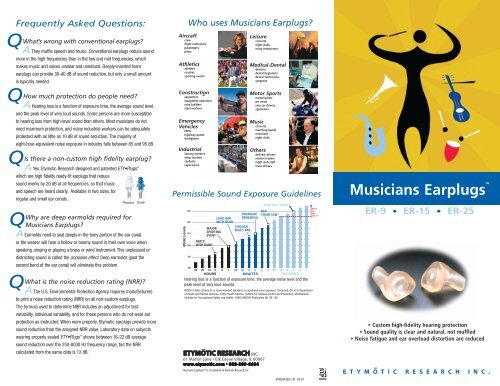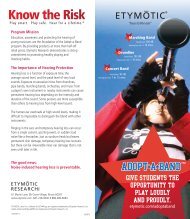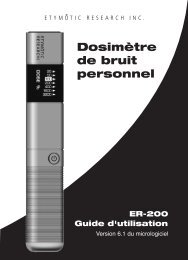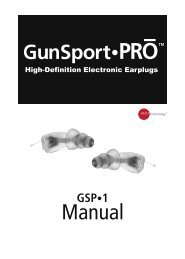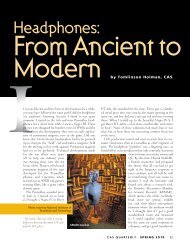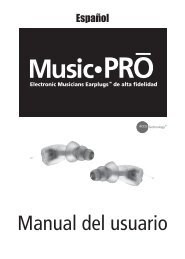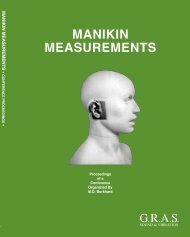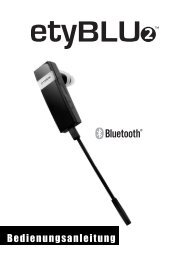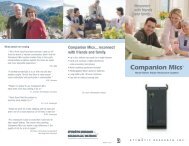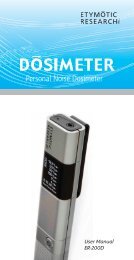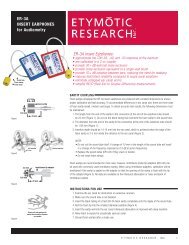Musicians Earplugs - Etymotic Research
Musicians Earplugs - Etymotic Research
Musicians Earplugs - Etymotic Research
You also want an ePaper? Increase the reach of your titles
YUMPU automatically turns print PDFs into web optimized ePapers that Google loves.
Q<br />
Frequently Asked Questions:<br />
What’s wrong with conventional earplugs?<br />
A They muffle speech and music. Conventional earplugs reduce sound<br />
more in the high frequencies than in the low and mid frequencies, which<br />
makes music and voices unclear and unnatural. Deeply-inserted foam<br />
earplugs can provide 30-40 dB of sound reduction, but only a small amount<br />
is typically needed.<br />
Q<br />
How much protection do people need?<br />
A Hearing loss is a function of exposure time, the average sound level,<br />
and the peak level of very loud sounds. Some persons are more susceptible<br />
to hearing loss from high-level sound than others. Most musicians do not<br />
need maximum protection, and many industrial workers can be adequately<br />
protected with as little as 10 dB of sound reduction. The majority of<br />
eight-hour-equivalent noise exposure in industry falls between 85 and 95 dB.<br />
Q<br />
Is there a non-custom high fidelity earplug?<br />
A Yes. <strong>Etymotic</strong> <strong>Research</strong> designed and patented ETY•Plugs which are high fidelity ready-fit earplugs that reduce<br />
sound evenly by 20 dB at all frequencies, so that music<br />
and speech are heard clearly. Available in two sizes, for<br />
regular and small ear canals.<br />
Q<br />
Why are deep earmolds required for<br />
<strong>Musicians</strong> <strong>Earplugs</strong>?<br />
A Earmolds need to seal deeply in the bony portion of the ear canal<br />
or the wearer will hear a hollow or boomy sound in their own voice when<br />
speaking, singing or playing a brass or wind instrument. This unpleasant or<br />
distracting sound is called the occlusion effect. Deep earmolds (past the<br />
second bend of the ear canal) will eliminate this problem.<br />
Q<br />
Regular Small<br />
What is the noise reduction rating (NRR)?<br />
A The U.S. Environmental Protection Agency requires manufacturers<br />
to print a noise reduction rating (NRR) on all non-custom earplugs.<br />
The formula used to determine NRR includes an adjustment for test<br />
variability, individual variability, and for those persons who do not wear ear<br />
protection as instructed. When worn properly, <strong>Etymotic</strong> earplugs provide more<br />
sound reduction than the assigned NRR value. Laboratory data on subjects<br />
wearing properly sealed ETY•Plugs shows between 18-22 dB average<br />
sound reduction over the 250-8000 Hz frequency range, but the NRR<br />
calculated from the same data is 12 dB.<br />
Who uses <strong>Musicians</strong> <strong>Earplugs</strong>?<br />
Aircraft<br />
crew<br />
flight instructors<br />
passengers<br />
pilots<br />
Athletics<br />
athletes<br />
coaches<br />
sporting events<br />
Construction<br />
carpenters<br />
equipment operators<br />
road builders<br />
steel workers<br />
Emergency<br />
Vehicles<br />
EMTs<br />
highway patrol<br />
firefighters<br />
Industrial<br />
factory workers<br />
shop teachers<br />
students<br />
supervisors<br />
Leisure<br />
concerts<br />
night clubs<br />
noisy restaurants<br />
ETYMOTIC RESEARCH INC.<br />
61 Martin Lane • Elk Grove Village, IL 60007<br />
www.etymotic.com • 888-389-6684<br />
<strong>Musicians</strong> <strong>Earplugs</strong> is a trademark of <strong>Etymotic</strong> <strong>Research</strong>, Inc.<br />
Medical-Dental<br />
dentists<br />
dental hygienists<br />
dental technicians<br />
surgeons<br />
Motor Sports<br />
motorcyclists<br />
pit crews<br />
race car drivers<br />
spectators<br />
Music<br />
concerts<br />
marching bands<br />
musicians<br />
night clubs<br />
Others<br />
delivery drivers<br />
market traders<br />
night club staff<br />
truck drivers<br />
Permissible Sound Exposure Guidelines<br />
Hearing loss is a function of exposure time, the average noise level and the<br />
peak level of very loud sounds.<br />
NIOSH (1998). Criteria for a recommended standard: occupational noise exposure. Cincinnati, OH: U.S. Department<br />
of Health and Human Services, Public Health Service, Centers for Disease Control and Prevention, and National<br />
Institute for Occupational Safety and Health. DHHS (NIOSH) Publication No. 98-126.<br />
EREM-B01-B 0210<br />
<strong>Musicians</strong> <strong>Earplugs</strong> <br />
ER-9 • ER-15 • ER-25<br />
• Custom high-fidelity hearing protection<br />
• Sound quality is clear and natural, not muffled<br />
• Noise fatigue and ear overload distortion are reduced<br />
E T Y M O T I C R E S E A R C H I N C .
fidelity<br />
/fidélitee/ n.<br />
1. faithfulness;<br />
loyalty. 2. strict<br />
conformity to<br />
truth or fact.<br />
3. exact<br />
correspondence<br />
to the original<br />
4. precision in<br />
reproduction of<br />
sound or video<br />
What Makes<br />
<strong>Musicians</strong> <strong>Earplugs</strong><br />
High Fidelity?<br />
<strong>Musicians</strong> <strong>Earplugs</strong> replicate the<br />
natural response of the ear canal so<br />
that sound heard with these earplugs<br />
has the same quality as the original,<br />
just quieter.<br />
UNPROTECTED EAR<br />
FOAM<br />
15 dB<br />
ER-9<br />
ER-15<br />
ER-25<br />
WITH ER-15 EARPLUG<br />
ER-15 Musician <strong>Earplugs</strong> provide 15 dB sound<br />
reduction at each frequency.<br />
Average sound reduction of <strong>Musicians</strong> <strong>Earplugs</strong> and<br />
foam earplugs.<br />
Permissible Sound Exposure Guidelines<br />
Continuous Unprotected Permissible<br />
Sound dBA Exposure Time<br />
85 8 hours<br />
88 4 hours<br />
91 2hours<br />
94 1hour<br />
97 30 minutes<br />
100 15 minutes<br />
103 7.5 minutes<br />
106 < 4 minutes<br />
109 < 2 minutes<br />
112 ~1minutes<br />
115 ~30seconds NIOSH (1998)<br />
About Musician <strong>Earplugs</strong><br />
<strong>Musicians</strong> <strong>Earplugs</strong> were designed to protect hearing<br />
while preserving all the subtleties and richness of music.<br />
Other earplugs, particularly foam, muffle sound so music<br />
and speech are not heard distinctly. <strong>Musicians</strong> <strong>Earplugs</strong><br />
are made from custom ear impressions and tested to<br />
ensure that sound heard with them is accurate and true<br />
—the definition of high fidelity. Music and speech<br />
reproduced through these earplugs sounds exactly as<br />
it would in an ear without an earplug, but at a lower<br />
(safer) loudness level.<br />
<strong>Musicians</strong> practice and perform in a variety of different<br />
settings and they are exposed to high levels of sound,<br />
sometimes for long periods. They require different<br />
amounts of hearing protection depending on the<br />
sound levels they encounter during rehearsals and<br />
performances. See the table to the right.<br />
Three types of<br />
attenuator buttons<br />
are available:<br />
ER-9, ER-15, and<br />
ER-25. The number<br />
corresponds with<br />
the amount of<br />
sound reduction<br />
provided in dB.<br />
Quick<br />
Reference<br />
Guide<br />
Description<br />
Button Colors<br />
Interchangability<br />
Earmold styles<br />
Insertion<br />
Cleaning<br />
Replacement<br />
ER-9 <strong>Musicians</strong> Earplug<br />
Flat 9 dB sound reduction through<br />
the mid range. Same high<br />
frequency protection as the ER-15<br />
Clear<br />
Which Earplug is Best for You?<br />
ER-9<br />
ER-15<br />
ER-25<br />
ER-20<br />
ER-15 <strong>Musicians</strong> Earplug<br />
Provides uniform 15 dB sound<br />
reduction across all frequencies<br />
Standard Partially countersunk Countersunk<br />
Harmful Sound Comes From:<br />
Small strings Own instrument, other strings<br />
Large strings Brass<br />
Woodwinds Brass, percussion<br />
Brass Own instrument, other brass<br />
Flutes Percussion<br />
Percussion Own instruments, other percussion<br />
Vocalists Own voice, speakers, monitors<br />
Acoustic guitar Drums, speakers, monitors<br />
Amplified instruments Speakers, monitors<br />
Marching bands Multiple sources<br />
Music teachers Multiple sources<br />
Recording engineers Speakers, monitors<br />
Sound crews Speakers, monitors<br />
Ref: Chasin, M. <strong>Musicians</strong> and the Prevention of Hearing Loss. Singular Publishing Group. 1996.<br />
Identical dimensions. Change buttons for different listening conditions.<br />
ER-25 <strong>Musicians</strong> Earplug<br />
Moisten the mold for ease of insertion.<br />
Pull the ear outward and upward while easing the mold into the ear canal.<br />
Remove button from mold. Use water and mild soap on the mold only.<br />
Dry mold thoroughly before replacing button.<br />
Provides 25 dB of relatively flat<br />
sound reduction across<br />
all frequencies<br />
Beige Brown<br />
Red Blue<br />
Discoloration, shrinkage, cracking, hardening of earmold material, deterioration in performance.<br />
<strong>Musicians</strong> <strong>Earplugs</strong> require custom earmolds. Deep impressions past the second bend of the ear canal must be taken to ensure<br />
the effectiveness of these earplugs and to reduce the occlusion effect.<br />
EtyPlugs


